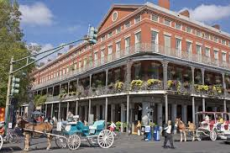
If you’ve seen the film the Princess and the Frog, Tiana lives and works in the city of New Orleans. New Orleans is located at the end of the Mississippi River, and has a long history of trade, foreign wars and slavery. However, it’s a little different from the rest of the Deep South, because it’s on a swamp called the Bayou. Watch out for the alligators, they’re not all as friendly as Louis in the Princess and the Frog! It also has a unique cultural and music scene, owing to its history of cultural diversity.
Before the Louisiana Purchase of 1803 (where America bought a load of land – I mean, loads. Almost a million square miles of land – from France for just $15 million. Bargain!), the city of New Orleans was the main hub of activity for the French part of the US. They imported slaves from Africa and the Caribbean, and bolstered slavery in the US. They built a lot of buildings in the centre, but they didn’t really invest that much outside of the city. Many of these French-style buildings survive today, in a place called the “French Quarter”.
The French Quarter is probably the most popular thing for tourists to do. You can just walk around and admire the architecture, which is so different from the rest of the US. It’s the oldest neighbourhood in the city, too. The balconies of the houses are made with very elaborate iron railings, which in turn were often built by slaves. Nightlife focuses around Bourbon Street, but walk around more and you’ll find some really great cafes and restaurants. You can try New Orleans Beignets, which are basically a type of doughnut eaten with sugar, and sometimes honey.
For a lazy way to see the city on a hot, humid day, try a riverboat cruise. Take a paddle steamer, like the ones from Mark Twain. The famous Natchez does cruises every day, and you can also have a dinner cruise should you fancy making a night of it. Remember that scene in the Princess and the Frog when they ride a boat back to New Orleans? That’s what a paddle steamer is!
Of course, the city’s history has been filled with tragedy recently. Go just a little away from the centre, and you’ll see the remains of houses that still haven’t been repaired since Hurricane Katrina, almost 10 years ago now. The Hurricane meant the Mississippi broke its banks (as well as the protective levees that had been installed) and flooded the city. Almost 2,000 people died during the storm and its aftermath, and the fast repair of the business district but lack of attention to the poorer areas reveals that institutional racism is still very much a problem in the USA.
New Orleans is also famous for its annual Mardi Gras carnival. After Rio, this is deemed the second-best parade in the world. Whilst we in England are eating pancakes and feeling bad about it (Mardi Gras is basically Pancake Day), people in New Orleans are out dressed in crazy costumes, throwing beads everywhere and dancing the night away. Though it’s bound to be popular during this time of year, it’s a once in a lifetime opportunity to see New Orleans in Mardi Gras. Let the music of Louis Armstrong inspire you and take you there.
Image from: http://www.mitratech.com/community/interact/visiting-new-orleans/

0 Comment:
Be the first one to comment on this article.